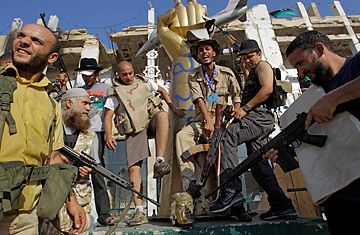
Rebel fighters gesture as they stamp on the head of a statue of Moammar Gaddafi inside the main compound in Bab Al-Aziziya in Tripoli, Libya, Tuesday, Aug. 23, 2011.
(2 of 2)
With no functioning Libyan government, one of the only ways to gauge Gaddafi's remaining strength is by the street fighting in Tripoli. Around 1 p.m. local time on Tuesday, loud explosions could be heard outside the leader's complex. Rebels converged around the perimeter with armored tanks and trucks mounted with heavy weaponry. Explosions and heavy automatic gunfire could be heard mid-morning near Green Square, the large open area near the Mediterranean seaport.
Despite the vicious fighting around the compound, there is no knowing whether the Libyan leader is there or whether he has fled elsewhere, perhaps to his hometown of Sirte, along the Mediterranean coast, or the southern oil town of Sabha, which are both under regime control and where tribal alliances might be able to harbor Gaddafi — leaving the areas around Libya's crucial oil fields in the Sahara likely too uncertain for oil companies to produce there, and perhaps inaccessible to a nascent rebel government. Gaddafi forces fired three Scud missiles on Tuesday on the town of Misratah from the direction of Sirte farther down the coast, according to NATO. The regime is thought to have had about 240 of the missiles before the war.
Also among the rebels' challenges is the fighting within Tripoli, a city of 2 million people, whose tall buildings and narrow streets provide opportunities for sniper attacks from Gaddafi holdouts. "Sadly for the guerrillas, urban warfare is the one kind of warfare in which you need training and coordination," Martin Navias, a defense analyst from Kings College London, told CNN on Tuesday morning. "I doubt many of those guerrillas have that capability." In addition, NATO forces are unlikely to risk bombing built-up areas of Tripoli without exact ground intelligence, Navias said. Aerial attacks have been essential to the rebels' advance so far. NATO spokesman Roland Lavoie told reporters on Tuesday that close air support for rebel fighters in Tripoli "would not be practical ... The situation in greater Tripoli is very complex. We're talking about urban fighting." Lavoie said the organization would not target Gaddafi if its aerial surveillance found the leader attempting to flee Libya. "Frankly, we would be happy," he told reporters. Only if Gaddafi were hiding inside a command and control center — regarded as a legitimate NATO target — would he be unwittingly targeted, he said.
The rebels were not the only ones whose credibility was in doubt on Tuesday. So too was that of the ICC in the Hague, which has indicted Saif al-Islam, his father and Gaddafi's security chief Abdallah al-Senousi on charges of crimes against humanity for allegedly organizing security forces to fire upon and kill unarmed protesters last February, before the rebels in eastern Libya took up weapons. Under ICC rules, a defendant is brought to trial after an arrest by a foreign government. Yet Libya never signed the ICC treaty, leaving the transfer of Saif and his father in considerable doubt — many rebels, in fact, would prefer to try the men in Libya.
Despite that, ICC officials said on Monday that they were discussing with rebel leaders how to transfer Saif to stand trial in the Hague. On Tuesday, that changed: ICC spokesman Fadi el Abdallah told the BBC that despite several attempts, the organization never received proof that Saif was under arrest. "We were trying to confirm the information," Abdallah said. "We tried to contact different persons from the NTC and got different information." In a similar way, information about Libya's war depends on whom one asks.
